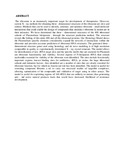In silico structure of the 40s ribosomal subunit from plasmodium falciparum as drug targetby homology and de novo modeling

View/
Date
2015Author
Mwangi, Harrison Ndung ’ u
Wagacha, Peter
Mathenge, Peterson
Sijenyi, Fredric
Mulaa, Francis
Type
PresentationLanguage
enMetadata
Show full item recordAbstract
The ribosome is an immensely important target for development of therapeutics. However,
current
X
-
ray methods for obtaining three
-
dimensional structures of the ribosome are slow and tedious.
Methods that can be used to identify, annotate, and optimize ribosome
-
small molecule interactions
that could enable the design of compounds that modulat
e ribosome fu
nction are in their infancies.
We have determined the three
-
dimensional structures of the 40S ribosomal subunit of
Plasmodium
falciparum
, through the structure prediction method. The structure reveals the folding of the entire
40S and all the
ribosomal proteins. Our Homology Model shows the Plasmodium specific
elements considerably expand the network of interactions within the ribosome and provides
accurate prediction of ribosomal RNA structures. The generated three
-
dimensional structure
gener
ated using homology and de novo modeling is of high resolution comparable in quality to
experimentally determined X
-
ray crystal structure. The model allows for identification of new
rRNA target sites and the specific motifs that are essential for Plasmodi
um ribosome functionality
and viability. Several regions of
P.falciparum
rRNA that contain nucleotides essential for viability
of the ribosome were identified. The sites include functionally important regions, known binding
sites for antibiotics, tRNA, pr
oteins, the large ribosomal subunit and initiation factors. Also
identified are a number of sites that are clearly essential for ribosome function, but for which no
functio
nal role has been identified.
The model is useful for screening compound libraries a
nd to carry out structural studies of
target/hit complexes, allowing optimization of hit compounds and validation of target using in
silico assays. The model is useful for exploiting regions of 16S rRNA that are unlikely to mutate,
thus generating anti
-
inf
ective natural products leads that would have decreased likelihood of
resistance development.
URI
http://www.napreca-tz.org/16napreca/16th_NAPRECA_Book_Abstracts.pdfhttp://hdl.handle.net/11295/92267
Citation
Mwangi, Harrison Ndung ’ u ., Wagacha, Peter., Mathenge, Peterson., Sijenyi, Fredric and Mulaa, Francis(2015). In silico structure of the 40s ribosomal subunit from plasmodium falciparum as drug targetby homology and de novo modeling. The 16th symposium of the natural products reseach network for eastern and central Africa (NAPRECA) 31st August to 3rd September 2015 Arusha, TanzaniaPublisher
University of Nairobi
